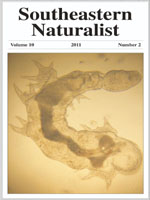We analyzed a naturalized population of Magnolia grandiflora L. occurring north of its native range in a temperate deciduous forest of the North Carolina piedmont. The population was likely expanding, based on its size-class distribution; however, it had not reached a reproductive size or age. The maximum size of established stems was 9.8 cm dbh and the maximum age, based on a subset of sampled stems, was 26 years. We analyzed the establishment of M. grandiflora trees with respect to several environmental variables. Climatic variables included annual minimum winter temperatures, frost-free periods, and precipitation, and topographic variables included elevation, aspect, and slope. We found a strong correlation between establishment and minimum winter temperatures as well as frost-free periods, but not with other environmental variables. Magnolia grandiflora has become naturalized north and west of its native range on the southeastern coastal plain; among the possible causes are climate change and the increased use of cold-hardy genotypes.
How to translate text using browser tools
1 June 2011
Magnolia grandiflora L. Range Expansion: A Case Study in a North Carolina Piedmont Forest
Jennifer A. Gruhn,
Peter S. White
ACCESS THE FULL ARTICLE

Southeastern Naturalist
Vol. 10 • No. 2
June 2011
Vol. 10 • No. 2
June 2011




